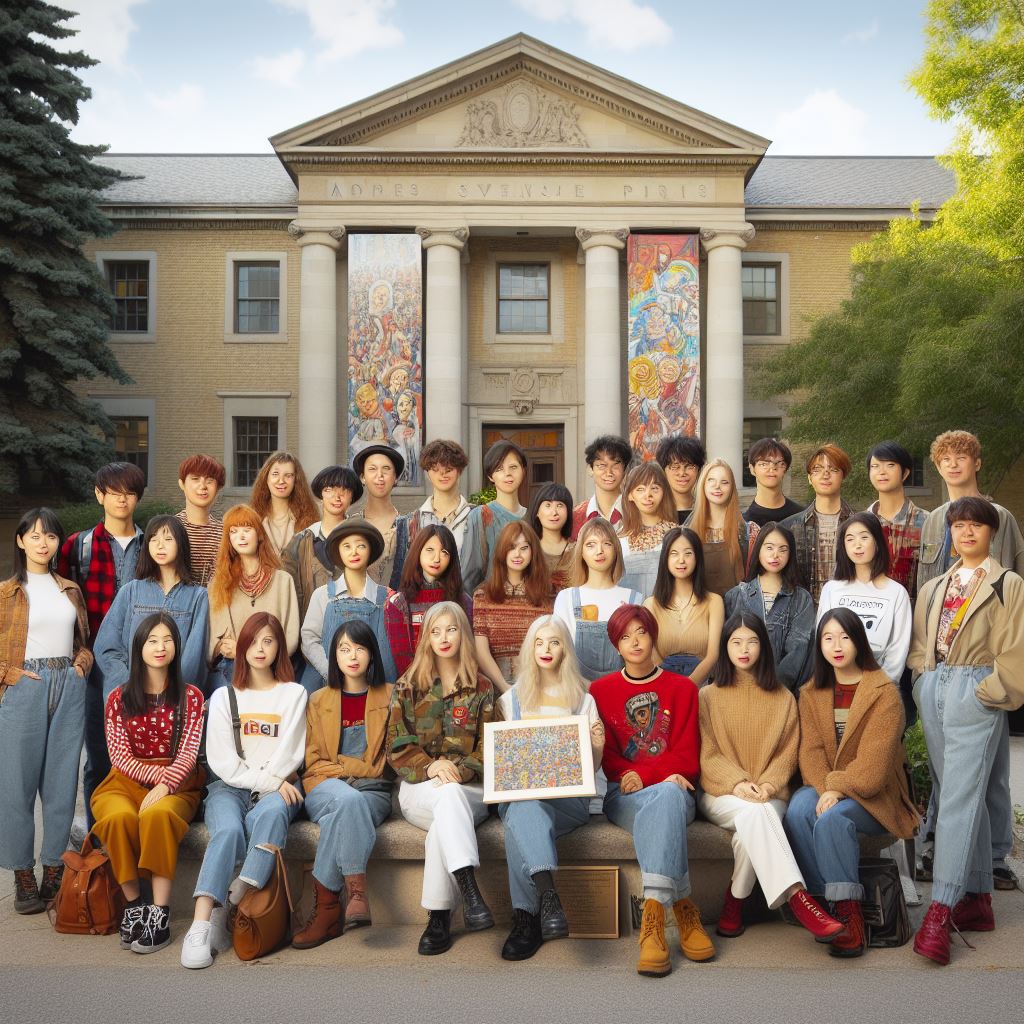Introduction
Art grants in Canada open doors for aspiring artists. They pave the way for creativity to flourish.
Significance
Art grants act as catalysts, fueling projects and dreams. They empower artists, fostering a vibrant cultural landscape.
Overview
- Exploring Opportunities: Uncover diverse grants available in Canada, from federal to provincial levels.
- Application Process: Break down steps, ensuring artists navigate applications effectively.
- Criteria and Eligibility: Understand what selectors seek. Ensure alignment with eligibility requirements.
- Tips for Success: Provide insights for crafting compelling proposals. Tips to stand out in a competitive field.
- Case Studies: Real-life examples showcase artists who thrived with grant support.
Embrace the journey of securing art grants.
This blog sets the stage for a transformative exploration into Canada’s vibrant artistic grant landscape.
Understanding Art Grants
Define what art grants are and how they work
Art grants are financial resources provided to artists to support their artistic endeavors.
They aim to encourage creativity and cultural development by providing funding for projects and activities.
Artists can apply for grants based on specific criteria and, if selected, receive financial support to realize their artistic visions.
The different types of art grants available in Canada
- Project Grants: These grants are awarded to artists who propose a specific project or body of work. They provide funds to cover production costs, research, materials, and exhibition expenses.
- Residency Grants: Residency grants offer artists the opportunity to live and work in artistic communities, providing them with time and resources to focus on their creative practice. These grants often include accommodation, studio space, and a stipend.
- Travel Grants: Artists can apply for travel grants to support their participation in exhibitions, conferences, and other artistic events both within Canada and internationally. These grants cover transportation, accommodation, and sometimes living expenses.
- Career Development Grants: These grants aim to support artists in advancing their careers. Funding is provided for activities such as workshops, mentorship programs, attending art fairs, and marketing initiatives.
The eligibility criteria for art grants
- Artist’s Track Record: Granting agencies typically require artists to have a portfolio of past work and a proven track record of artistic achievements.
- Project Proposal: A strong and well-defined project proposal that demonstrates artistic merit and aligns with the grant’s objectives is crucial to securing an art grant.
- Artistic Merit: Art grants are often awarded based on the artistic merit and potential impact of the proposed project. The originality, concept, and artistic relevance play a significant role in the selection process.
- Residency or Location: Some grants may have specific criteria related to residency or the artist’s location, such as prioritizing artists from specific communities or regions in Canada.
The benefits of receiving an art grant
- Financial Support: Art grants provide artists with the financial means necessary to pursue ambitious projects that may be otherwise financially challenging to realize.
- Professional Recognition: Receiving an art grant enhances an artist’s reputation and provides validation of their artistic practice. It can open doors to new opportunities, such as exhibitions, residencies, and collaborations.
- Networking and Exposure: Art grants often provide artists with access to professional networks, audiences, and exhibition opportunities that can boost their exposure and foster career growth.
- Time and Space for Creativity: Grants that include residencies or time-based support allow artists to dedicate themselves fully to their creative process, free from financial constraints and distractions.
In short, art grants play a crucial role in supporting and nurturing the artistic community in Canada.
Understanding the different types of grants available, eligibility criteria, and the benefits they offer can empower aspiring artists to seek funding opportunities and realize their artistic visions.
Read: Breaking In: How to Start Your Art Career in Canada
Researching Art Grant Opportunities
List of Reputable Art Grant Organizations in Canada
- Canada Council for the Arts
- Ontario Arts Council
- Alberta Foundation for the Arts
- British Columbia Arts Council
- Manitoba Arts Council
- Québec Arts Council
- Nova Scotia Arts Council
- Saskatchewan Arts Board
- Newfoundland and Labrador Arts Council
- Yukon Arts Centre
Importance of Thorough Research
Thorough research helps artists understand the grant requirements, eligibility criteria, and submission guidelines.
How Artists Can Find Art Grant Opportunities
- Visit the websites of art grant organizations.
- Follow their social media accounts to stay updated on new opportunities.
- Attend local art events and network with other artists who may have information on grants.
- Subscribe to newsletters and mailing lists of art organizations.
Tips for Narrowing Down the Options
In Canada, artists seeking grants must align with their practice and focus on specific mediums.
Research past recipients and assess compatibility. Consider funding amounts and support levels provided by grants.
Evaluate eligibility criteria before applying, ensuring all requirements are met.
Thoroughly read application guidelines to understand expectations.
Seek advice from experienced artists or professionals who applied successfully.
Prioritize grants with mentorship programs and additional resources for comprehensive support. Explore reputable organizations such as:
- Canada Council for the Arts: National funding agency supporting various artistic disciplines.
- Ontario Arts Council: Fosters artistic excellence and accessibility in Ontario.
- Alberta Foundation for the Arts: Supports artistic development and presentations in Alberta.
- British Columbia Arts Council: Grants for artists, organizations, and cultural projects in British Columbia.
- Manitoba Arts Council: Backs production, creation, and presentation of arts in Manitoba.
- Québec Arts Council: Grants for professional artists and organizations in Québec.
- Nova Scotia Arts Council: Financial assistance for artistic development in Nova Scotia.
- Saskatchewan Arts Board: Supports artists and organizations through grants and programs.
- Newfoundland and Labrador Arts Council: Funds artistic projects in Newfoundland and Labrador.
- Yukon Arts Centre: Offers various grants and programs supporting the arts in the Yukon.
Thorough research is crucial. Explore organization websites, social media, and network at local events. Subscribe to newsletters for updates on new grants.
With careful consideration and active research, artists can identify suitable opportunities to advance their careers in Canada.
Read: The Future of Writing Careers in Canada
Crafting a Strong Grant Proposal
The importance of a well-written grant proposal
A well-written grant proposal is crucial as it serves as the primary tool for persuading grantors to fund an artist’s project.
It demonstrates professionalism, clarity, and a compelling case for financial support.
Provide tips for writing a compelling artist statement
- Define personal artistic vision and unique style.
- Use concise language that captivates and reflects the artist’s passion.
- Explain the inspiration and motivation behind the artwork.
- Show how the artist’s work contributes to the artistic community and society.
- Ensure the statement is well-structured and free from grammar or spelling errors.
Outline the necessary components of a grant proposal
- Cover letter: Introduce the proposal, artist, and project concisely.
- Artist statement: Describe the artist’s background, style, and artistic goals.
- Project description: Clearly define the proposed project, its objectives, and expected outcomes.
- Budget: Present a detailed and realistic breakdown of the project’s financial needs.
- Timeline: Outline the project’s phases and deadlines, ensuring a feasible schedule.
- Supporting materials: Include an artistic portfolio, résumé, and letters of recommendation.
- Conclusion: Summarize the proposal and express gratitude to the grantor for their consideration.
Discuss the importance of a strong artistic portfolio
A strong artistic portfolio showcases an artist’s talent, skills, and artistic range, which significantly influence grantors’ perception of the artist’s potential for success.
It provides visual evidence of their capability to execute the proposed project.
Unlock Your Career Potential
Visualize a clear path to success with our tailored Career Consulting service. Personalized insights in just 1-3 days.
Get Started- Highlight the significance of accurately following application guidelines:
Following the application guidelines is crucial for two reasons. First, it demonstrates the artist’s attention to detail and ability to comply with requirements. Second, it ensures that the proposal meets the grantor’s expectations, increasing the chances of securing funding. - Emphasize the need for thorough research on grantors.
Researching potential grantors helps artists identify those whose funding priorities align with their artistic goals. Understanding a grantor’s mission, values, and past recipients can provide valuable insights for tailoring the grant proposal to increase its appeal. - Provide advice on seeking feedback and editing before submission.
Seeking feedback from trusted peers, mentors, or professionals in the field allows artists to receive constructive criticism and improve their grant proposal. Several rounds of editing are essential to refine the proposal’s clarity, coherence, and persuasiveness. - Stress the significance of submitting the grant proposal before the deadline.
Submitting the grant proposal ahead of the deadline demonstrates professionalism and respect for the grantor’s time. It also allows for any unforeseen delays or technical difficulties that may arise during the submission process. - Encourage artists to maintain a positive mindset throughout the grant application process.
Rejections are inevitable in the competitive grant application process. Artists should stay resilient, learn from each application, and continue seeking opportunities, knowing that persistence and growth are vital for success in the artistic field.

Submitting the Grant Application
Application Process
- Start by carefully reviewing the guidelines and instructions provided by the grant program.
- Prepare a concise and compelling artist statement that highlights your artistic vision and goals.
- Outline your project plan or proposal, including the objective, timeline, and anticipated outcome.
- Include a detailed budget that clearly outlines how the grant funds will be used.
- Attach your résumé or curriculum vitae, emphasizing your artistic achievements and experience.
- Secure letters of recommendation from professionals who can speak to your artistic talent.
Checklist of Required Documents and Materials
- Completed grant application form.
- Artist statement outlining your artistic vision and goals.
- Project plan or proposal with objectives, timeline, and anticipated outcome.
- Detailed budget explaining the allocation of grant funds.
- Résumé or curriculum vitae highlighting your artistic achievements and experience.
- Letters of recommendation from professionals in the field.
Submission Deadlines and Additional Requirements
- Pay close attention to the submission deadlines specified by the grant program.
- Make sure to meet the application submission deadline to ensure your eligibility.
- Be aware of any specific requirements, such as file formats or maximum file sizes for attachments.
- Verify if the grant program requires additional supporting materials, such as samples of previous work.
Tips for Organizing and Presenting Application Materials
- Create a clear and organized folder or binder to store all application materials.
- Ensure that each document is properly labeled and easily accessible.
- Proofread your application to eliminate any grammatical or spelling errors.
- Consider seeking feedback from trusted individuals before finalizing your application.
- Follow any specific formatting guidelines provided by the grant program.
- Double-check that all required documents and materials are included before submitting.
Submitting a grant application for art funding can be a competitive process, but with careful preparation and attention to detail, you can maximize your chances of success.
Follow the guidelines provided by the grant program, compile all necessary documents, and meet the submission deadlines.
By organizing and presenting your application materials effectively, you can showcase your artistic talent and secure the funding you need to bring your creative vision to life.
Read: Canadian Musician Success Stories: Inspirations
Following Up and Dealing with Rejections
The Importance of Following Up on Grant Applications
- Following up on grant applications is crucial to demonstrate your dedication and professionalism.
- It shows respect towards the granting organization and keeps you on their radar for future opportunities.
- Following up allows you to inquire about the status of your application and obtain valuable feedback.
- It provides an opportunity to establish relationships and network with the grant program administrators.
- By following up, you can also ensure that there were no technical glitches or miscommunications during the application process.
Guidance on How to Handle Rejection
- Rejection is a common part of the art grant application process, so it’s important not to take it personally.
- First, take some time to process the rejection and allow yourself to feel the emotions associated with it.
- Reflect on your application and try to identify any areas where you can improve for future submissions.
- Remember that rejection doesn’t define your artistic abilities or the worth of your work.
- Seek support from fellow artists, friends, or mentors to help you navigate through the disappointment.
- Use rejection as motivation to push yourself further and strive for even greater artistic achievements.
Tips for Seeking Feedback on Unsuccessful Applications
- Reach out to the granting organization and politely request feedback on your unsuccessful application.
- Be specific in your request, asking for details on areas where your application fell short or any weaknesses observed.
- Listen to the feedback with an open mind and avoid becoming defensive or argumentative.
- Take notes on the feedback provided and use it constructively to enhance your future applications.
- Consider joining artist communities or organizations that offer peer critiques and feedback to improve your work.
- Engage in self-reflection and self-critique to analyze your own application and identify areas for improvement.
Encouragement to Persevere and Reapply in the Future
- Remember that rejection is a temporary setback and an opportunity for growth.
- Develop resilience and learn from each rejection, using it as a stepping stone towards improvement.
- View rejections as a means to refine your artistic practice and polish your grant application skills.
- Stay determined, motivated, and continue pursuing your artistic vision despite setbacks.
- Network with other artists, attend workshops, and seek mentorship to further enhance your chances for success.
- Reapply for grants in the future, incorporating the feedback received and showcasing your growth as an artist.
As an aspiring artist, following up on grant applications, handling rejection, seeking feedback, and persevering are essential steps in your journey towards securing art grants in Canada.
Remember, each rejection brings an opportunity for growth, and with determination, you can ultimately achieve your artistic goals. Keep pushing forward and never lose sight of your passion.
Read: Networking in Music: Canadian Industry Events
Delve into the Subject: The Road to Becoming a Canadian Reporter
Success Stories and Testimonials
Share success stories of artists who have received art grants
- Marie, a painter from Montreal, received an art grant that allowed her to create a solo exhibition.
- John, a filmmaker from Vancouver, used an art grant to produce his first feature film which gained international recognition.
- Sarah, a sculptor from Toronto, received an art grant that enabled her to showcase her work in renowned galleries.
Feature testimonials from artists who have benefited from art grants
- “Receiving an art grant gave me the financial support I needed to pursue my passion without worrying about living expenses.” – Alex, photographer
- “Art grants not only provided me with funding but also boosted my confidence and credibility as an artist.” – Emily, mixed media artist
- “Thanks to an art grant, I had the opportunity to collaborate with renowned musicians and expand my artistic horizons.” – Michael, composer
The positive impact of art grants on artistic careers
- Art grants provide artists with the necessary resources to take risks and explore new artistic directions.
- Receiving an art grant can open doors to exhibitions, collaborations, and networking opportunities.
- Art grants offer artists recognition and validation, helping them to establish themselves in the art world.
Offer inspiration and motivation for aspiring artists
Are you an aspiring artist? Don’t be discouraged! Many successful artists began their careers with the help of art grants.
These grants can be transformative, providing you with the means to turn your creative dreams into reality.
With hard work, dedication, and a compelling artistic vision, you too can achieve success.
Apply for art grants, explore different avenues, and don’t be afraid to take risks. Remember, every great artist was once an aspiring artist.
So, what are you waiting for? Start researching art grants, prepare a compelling application, and chase your artistic dreams.
The possibilities are endless, and your journey to success begins now!
Read: The Future of Journalism in Canada
Conclusion
Throughout this blog post, we have discussed important information regarding art grants in Canada.
Art grants play a crucial role in supporting aspiring artists by providing financial aid and resources.
It is highly encouraged that readers take advantage of the available art grant opportunities in Canada.
In closing, I urge all readers to pursue their artistic dreams passionately and fearlessly. Embrace the art grant opportunities and unlock your full potential as an artist.
Don’t let anything hold you back from creating the masterpiece you were born to make. The time is now. Take action and make your dreams a reality.




